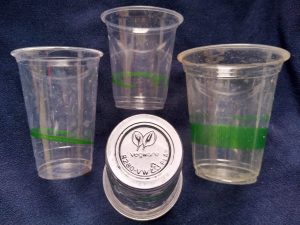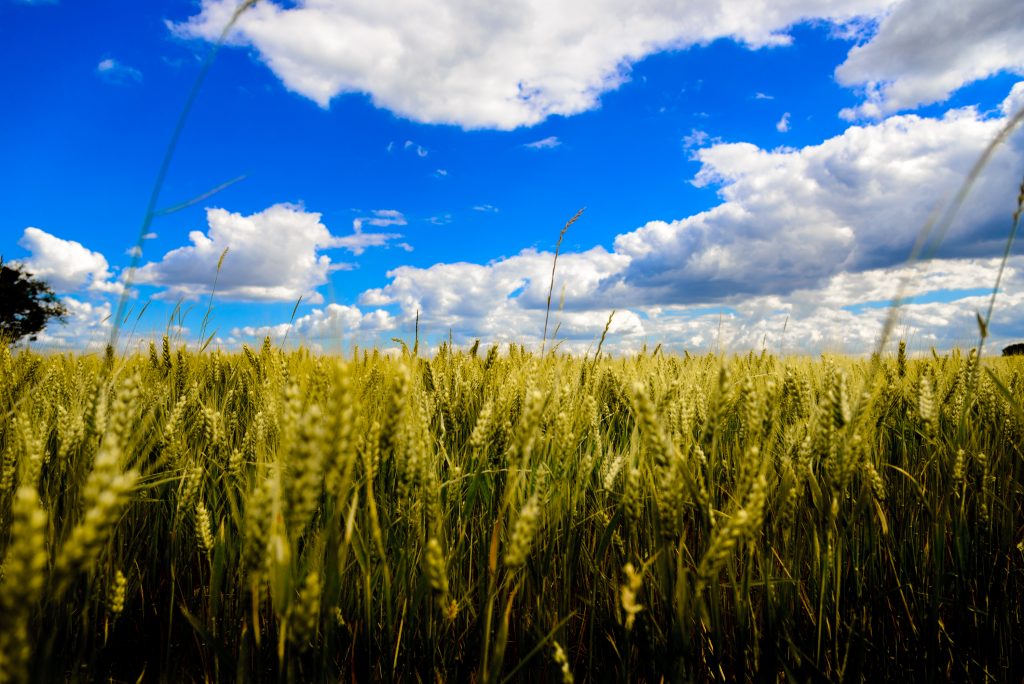A Plant-Based Future: Bioplastics and Optimism through Consumer Choices
Here we are at the end of a four-part series on plastics in observation of Plastic-Free July. Now that we’ve suffered through glimpsing a small amount of the environmental problems caused by plastics, let’s look ahead to see where the future leads—the green future.
 Polylactic acid. You love it, I love it. It’s the stuff dreams are made of. Okay, maybe not really, but it’s an important step in the right direction. Without dabbling too much in the chemistry, PLA is a bioplastic, or a polymer derived from renewable biomass (in this case, corn). It has a wide variety of applications from 3D printer feedstock to medical implants and decomposable packing. Here at the garden, we use PLA cups for refreshments on boat tours during hot summer days.
Polylactic acid. You love it, I love it. It’s the stuff dreams are made of. Okay, maybe not really, but it’s an important step in the right direction. Without dabbling too much in the chemistry, PLA is a bioplastic, or a polymer derived from renewable biomass (in this case, corn). It has a wide variety of applications from 3D printer feedstock to medical implants and decomposable packing. Here at the garden, we use PLA cups for refreshments on boat tours during hot summer days.
To understand the advantages of a plant polymer plastic, let’s first look at the shortcomings of petroleum plastics. For starters, petroleum plastics aren’t sustainable—there’s a limited amount of petroleum on the planet, and aside from the cost issue of scarcity, it will run out. Not only is their production and proliferation damaging to the environment, but they can leech toxic chemicals like Bisphenol A (BPA) into our systems. Another issue is that petrol-plastics are unlikely to fully break down into constituent organic molecules, and as we’ve seen previously, they just end up being a microplastic nightmare.
 PLAs address these issues. Because they are produced from a sustainable source—plants—they have potential to be produced indefinitely. Being plant-based, they’re also beneficial rather than degrading to the environment and climate situation. PLAs are not, however, a silver bullet for our plastic problems. Though they’re more conducive to decomposing back to organic elements than petrol-plastics, this doesn’t happen in a backyard compost pile in a reasonable amount of time. Instead, specially-designed industrial composting facilities are necessary to break down and recycle these products back into something useful. Along these lines, PLAs (labelled “7” in recycling) can’t be recycled by normal recycling facilities either, and putting them into the recycling stream makes regular recycling less efficient and less profitable—less profit means less support for the endeavor overall. This potential for mixed plastics is one reason composting facilities typically only accept bioplastics from non-household clients. Critics often cite this lack of infrastructure as a deterrent from supporting a shift to bioplastics. But the era of bioplastics has just begun, and in time they will grow into a ubiquitous and renewable commodity as more people make the sustainable switch. PLAs and bioplastics can’t be used for everything (yet), but they are available as a budding opportunity to make plastics better. Currently, PLAs are sourced from feed corn used for animal agriculture; this is land intensive and requires the use of GMOs (which do have their merits—a separate discussion for another day), but PLAs nonetheless have the potential to benefit both humanity and the planet in the long run. Shifting to less animal-focused agriculture would free up these resources, along with other environmental benefits.
PLAs address these issues. Because they are produced from a sustainable source—plants—they have potential to be produced indefinitely. Being plant-based, they’re also beneficial rather than degrading to the environment and climate situation. PLAs are not, however, a silver bullet for our plastic problems. Though they’re more conducive to decomposing back to organic elements than petrol-plastics, this doesn’t happen in a backyard compost pile in a reasonable amount of time. Instead, specially-designed industrial composting facilities are necessary to break down and recycle these products back into something useful. Along these lines, PLAs (labelled “7” in recycling) can’t be recycled by normal recycling facilities either, and putting them into the recycling stream makes regular recycling less efficient and less profitable—less profit means less support for the endeavor overall. This potential for mixed plastics is one reason composting facilities typically only accept bioplastics from non-household clients. Critics often cite this lack of infrastructure as a deterrent from supporting a shift to bioplastics. But the era of bioplastics has just begun, and in time they will grow into a ubiquitous and renewable commodity as more people make the sustainable switch. PLAs and bioplastics can’t be used for everything (yet), but they are available as a budding opportunity to make plastics better. Currently, PLAs are sourced from feed corn used for animal agriculture; this is land intensive and requires the use of GMOs (which do have their merits—a separate discussion for another day), but PLAs nonetheless have the potential to benefit both humanity and the planet in the long run. Shifting to less animal-focused agriculture would free up these resources, along with other environmental benefits.
Throughout this series, we’ve seen that there’s no quick answer to plastic pollution or environmental problems. Often when we implement a solution to pollution, it ends up being more resource intensive than the alternative and can exacerbate the climate crisis—an earthly game of whack-a-mole. But what can be done is for us to put our money where our mouth is. Many of the problems we have in environmentalism stem from our instinct to seek the cheapest mode of convenience. By resisting this impulse, we can enact real change. Eco-friendly products tend to be more expensive than their damaging counterparts, but the market responds to the demands of the people. If consumers show they’re willing to pay an extra dollar for eco-friendly soap or soyrizo, manufacturers and companies will respond in kind by jostling to make them more available and affordable. If consumers stop using superfluous plastic bags, straws and other single-use items, companies will stop stocking them. Even the most strong-willed and well-intentioned person can flounder and faulter in the face of seemingly-insurmountable environmental issues. But the point is not to be perfect about it, the point is to do your best, strive to be consistent, and inspire others to do the same.
Photos sourced from Wikimedia Commons







